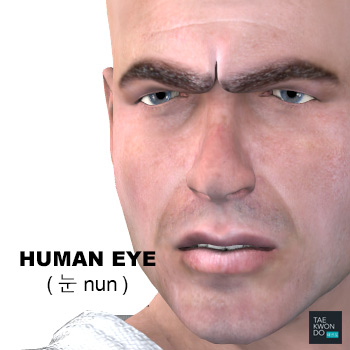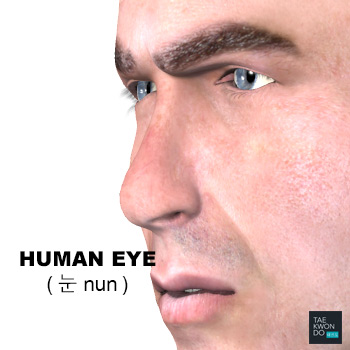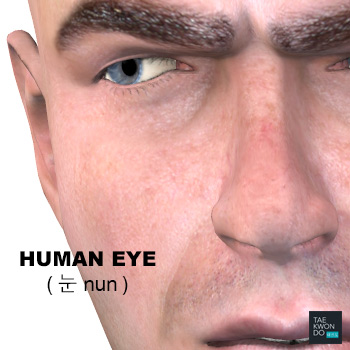Taekwondo 태권도Taekwondo Preschool
Promotion from one geup to the next can proceed rapidly in some schools, since schools often allow geup promotions every two, three, or four months. Students of geup rank learn the most basic techniques first, and then move on to more advanced techniques as they approach first dan. Many of the older and more traditional schools often take longer to allow students to test for higher ranks than newer, more contemporary schools, as they may not have the required testing intervals. View Taekwondo belt levels »

Human Eye
( 눈 nun )
Difficulty Level: Advanced Level Surface: Offensive Target
The human eye ( 눈 nun ) is an organ that reacts to light and allows vision. Rod and cone cells in the retina allow conscious light perception and vision including color differentiation and the perception of depth. The human eye can differentiate between about 10 million colors and is possibly capable of detecting a single photon. The eye is part of the sensory nervous system.
The eye is not shaped like a perfect sphere, rather it is a fused two-piece unit, composed of the anterior segment and the posterior segment. The anterior segment is made up of the cornea, iris and lens. The cornea is transparent and more curved, and is linked to the larger posterior segment, composed of the vitreous, retina, choroid and the outer white shell called the sclera. The cornea is typically about 11.5 mm (0.3 in) in diameter, and 1/2 mm (500 μm) in thickness near its center. The posterior chamber constitutes the remaining five-sixths; its diameter is typically about 24 mm. The cornea and sclera are connected by an area termed the limbus. The iris is the pigmented circular structure concentrically surrounding the center of the eye, the pupil, which appears to be black. The size of the pupil, which controls the amount of light entering the eye, is adjusted by the iris' dilator and sphincter muscles.
Light energy enters the eye through the cornea, through the pupil and then through the lens. The lens shape is changed for near focus (accommodation) and is controlled by the ciliary muscle. Photons of light falling on the light-sensitive cells of the retina (photoreceptor cones and rods) are converted into electrical signals that are transmitted to the brain by the optic nerve and interpreted as sight and vision.
* Please see a certified Master Instructor ( 사범님 sabeomnim ) for training. Proper guidance and instructions are needed to ensure safe training.

Impact Surface Area
Various surfaces of the hand and feet may be engaged as the striking or blocking surface depending on which area of the opponents body is being targeted. This leads to a large array of hand and feet positions. The human body's shape is determined by a strong skeleton made of bone and cartilage, surrounded by fat, muscle, connective tissue, organs, and other structures. For more information View Impact Surface Area »
- Fist ( 주먹 jumeok )
- Hammer Fist ( 메주먹 mejumeok )
- Hand Blade ( 손날 sonnal )
- Ridgehand ( 손날등 sonnal-deung )
- Forearm ( 앞팔 ap-pal )
- Inner Wrist ( 안팔목 anpalmok )
- Outside Wrist ( 바깥팔목 bakkatpalmok )
- Elbow ( 팔굽 palgup )
- Back Knuckle ( 등주먹 deung-jumeok )
- Arm ( 팔 pal )
- Hand ( 손 son )
- Finger ( 손가락 songalag )
- Palm ( 손바닥 sonbadak )
- Palm Heel ( 바탕손 batangson )
- Fingertips ( 손끝 sonkkeut )
- Scissors Fingertips ( 가위손끝 kawisonkkeut )
- Combined Two Fingertips ( 모은두손끝 moeundusonkkeut )
- Single Fingertip ( 한손끝 hansonkkeut )
- Combined Three Fingertips ( 모은세손끝 moeunsesonkkeut )
- Flat Fingertips ( 편손끝 pyeonsonkkeut )
- Back Hand ( 손등 sondeung )
- Wrist Area ( 팔목 palmok )
- Back of the Wrist ( 등팔목 deung-palmok )
- Base of the Wrist or Inner Wrist ( 밑팔목 mitpalmok )
- Arc Hand ( 아금손 ageumson )
- Pincers Finger ( 집게주먹 jipgejumeok )
- Bent Wrist ( 굽힌손목 gupinsonmok )
- Curled Fingertips ( 모둠손끝 modumsonkkeut )
- Extended Knuckle Fist ( 밤주먹 bamjumeok )
- Half-clenched Fist ( 편주먹 pyeonjumeok )
- Trigger Finger Fist ( 집게밤주먹 jipgebamjumeok )
- Curled Hand ( 곰손 gomson )
- Foot ( 발 bal )
- Ball of the Foot ( 앞축 apchuk )
- Instep of the Foot ( 발등 baldeung )
- Bottom of the Heel ( 뒤축 dwichuk )
- Sole of the Foot ( 발바닥 balbadak )
- Foot Blade ( 발날 balnal )
- Shin ( 정강이 jeonggangi )
- Ankle ( 발목 balmog )
- Reverse Foot Blade ( 발날등 balnaldeung )
- Tips of the Toes ( 발끝 balkkeut )
- Knee ( 무릎 mureup )
- Back of the Heel ( 뒤꿈치 dwikkumchi )
- Back of the Knee ( 오금 ogum )
- Thigh ( 허벅지 heobeokji )
- Head ( 머리 meoli )
- Face ( 얼굴 eolgul )
- Human Eye ( 눈 nun )
- Ear ( 귀 gwi )
- Temple ( 관자놀이 gwanjanoli )
- Nose ( 코 ko )
- Teeth ( 이 i )
- Chin ( 턱 teog )
- Jaw ( 턱 teog )
- Throat ( 목구멍 mokgumeong )
- Neck ( 목 mok )
- Cervical Vertebrae ( 경추 gyeongchu )
- Shoulder ( 어깨 eokkae )
- Collarbone ( 쇄골 swaegol )
- Chest ( 가슴 gaseum )
- Ribs ( 늑골 neuggol )
- Sternum ( 흉골 hyung-gol )
- Abdomen ( 복부 bogbu )
- Groin ( 샅 sat )
- Hamstring ( 햄스트링 haemseuteuling )
There are five tenets defined in the International Taekwondo Federation (ITF) and several more in World Taekwondo (WT).
Indomitable Spirit ( 백절불굴 baekjul-boolgool ): "To have indomitable spirit means to have the courage to stand up for what you believe in, no matter what odds you are up against, and to always give 100% effort in whatever you do." View Taekwondo Tenets »
RESOURCES
This article uses material from the Wikipedia articles "Human Eye" and "List of Taekwondo techniques", which is released under the Creative Commons Attribution-Share-Alike License 3.0.






























